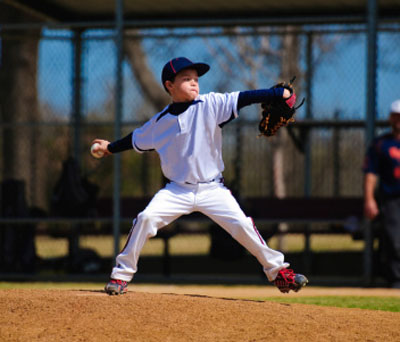
Youth baseball season is in full swing. However, it now seems that the competitive nature of the sport drives young baseball players to compete year-round. The result? An increased risk for overuse injuries — especially in baseball pitchers.
When athletes don’t take time off, the parts of the body required for repeated movements in throwing, jumping or pivoting don’t have enough time to recover. That can be particularly hard on growing bodies.
“Children ages 12 to 16 are at highest risk for these problems,” says Jeffrey Nepple, MD, a Washington University orthopedic surgeon and pediatric sports medicine specialist at St. Louis Children’s Hospital. “They’re undergoing growth spurts and are changing at rates that are faster than any other time during their lives. That’s when they’re at the greatest risk for injuring themselves.”
Multiple sports are the best game plan
“If you concentrate in a specific sport, you tend to overuse certain muscles and joints in certain areas, and muscle development isn’t well balanced,” says Gregory Finn, MD, a Washington University clinical associate pediatrician at Blue Fish Pediatrics. “Children who play multiple sports tend to have a lower incidence of overuse injuries. Plus, participating in a variety of sports will condition children to be better athletes in any single sport.”
Dr. Nepple adds, “Year-round specialization in a single sport at an early age is probably not beneficial for musculoskeletal development as well as coordination — aspects that are usually overlooked. There is value to cross- training and playing different sports; and the risk of injury is lessened in the long-term.”
Down time is good time
In addition to varying their activities and alternating those from season to season, Dr. Nepple recommends having at least one or two rest days each week. Dr. Finn emphasizes that young athletes should take a break from all sports for one month each year.
Pitches do count
Parents and coaches can reduce a child’s risk for overuse injuries even more by keeping track of specific motions. For instance, the American Sports Medicine Institute advises adolescent baseball pitchers to pitch no more than 100 innings in games in any calendar year, and to stop overhead throwing of any kind for four months annually. Recommended limits on the number of pitches athletes should throw per game (two games maximum per week):
Age daily pitch limit
17-18 106
15-16 91
13-14 76
11-12 68
8-10 52
In addition to limiting the number of pitches thrown per day, pitchers should limit the number of days they throw per week. “The daily pitch limit represents the maximum number of pitches for one day, but pitchers should not throw at these levels for multiple days in a row,” says Dr. Nepple. “Pitchers need to rest their arms between games.
At the end of the day, it comes down to coaches and the parents. It’s important to be knowledgeable about overuse injuries. Sometimes coaches put pressure on their best players to play, but parents have the best opportunity to protect their children.”
Dr. Finn sees patients at Blue Fish Pediatrics, 12360 Manchester Road, Suite 100. Please call 314-966-8500 for an appointment.
Dr. Nepple sees patients at the Center for Advance Medicine, Orthopedic Surgery Center, 6th floor, Suite A. Please call 314-514-3500 for an appointment.
St. Louis Children’s Hospital Orthopedic Surgery, 4S-60, One Children’s Place. Please call 314-514-3500 for an appointment.
St. Louis Children’s Specialty Care Center, 13001 North Outer Forty